Coral Bleaching
2022 MAR 30
Mains >
Environment & Ecology > Biodiversity > Oceanography

WHY IN NEWS?
- Recently, the Great Barrier Reef Marine Park Authority of Australia has declared that a wide stretch of the Great Barrier Reef has been hit by a sixth mass bleaching event.
MORE ON THE NEWS:
- It is the fourth time in six years that such severe and widespread damage caused by warm sea temperatures has been detected.
- Only two mass bleaching events had ever been recorded until 2016.
- There are particular concerns that this bleaching event has occurred in the same year in a year of La Niña, when more rain and cooler temperatures were supposed to provide a moment of respite for sensitive corals to recover.
- This shows the long-term warming trend of climate change.
- Scientists are now fearful of the damage that could be caused by the next El Niño.
|
Great Barrier Reef
- The Great Barrier Reef is the world's largest coral reef system
- The reef is located off the coast of Queensland, Australia, in the Coral Sea.
- It supports a wide diversity of life with 400 types of coral, 1,500 species of fish and 4,000 types of molluscs and was selected as a World Heritage Site in 1981.
- The Great Barrier Reef can be seen from outer space and is the world's biggest single structure made by living organisms.
- Much of the Great Barrier Reef is a marine protected area, managed by the Great Barrier Reef Marine Park Authority of Australia.
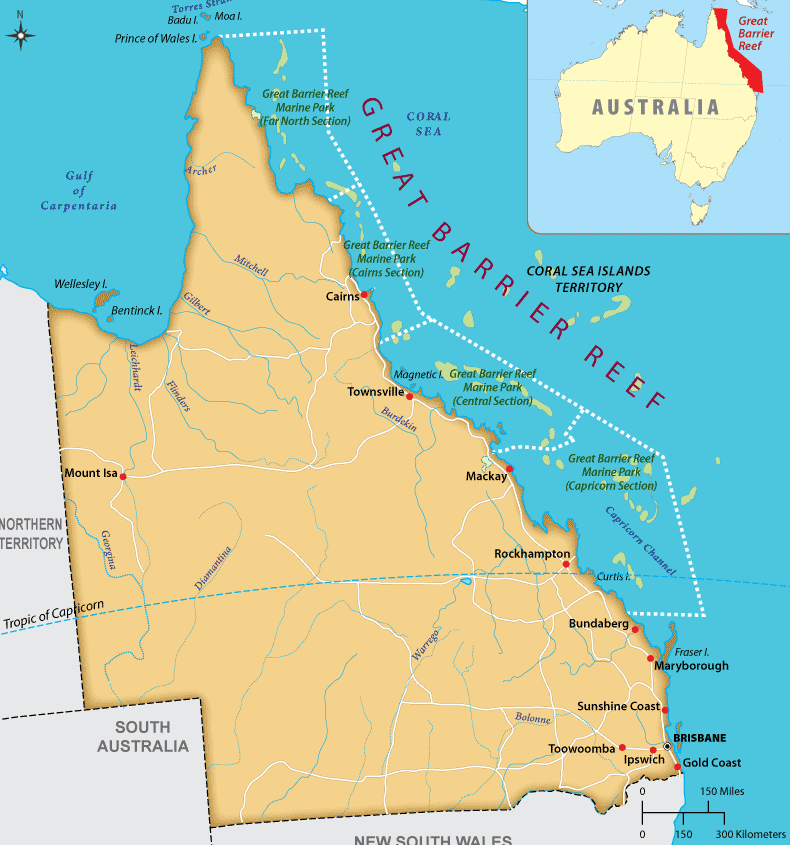
|
WHAT ARE CORAL REEFS?
- Coral reefs are large underwater structures composed of the skeletons of colonial marine invertebrates called coral.
- Each individual coral is referred to as a polyp.
- Coral polyps live on the calcium carbonate exoskeletons of their ancestors, adding their own exoskeleton to the existing coral structure.
- The coral species that build reefs are known as hermatypic or "hard" corals because they extract calcium carbonate from seawater to create a hard, durable exoskeleton that protects their soft, sac-like bodies. Other species of corals that are not involved in reef building are known as “soft” corals.
- The corals have a symbiotic, or mutually beneficial, relationship with photosynthetic algae called zooxanthellae.
- Zooxanthellae live inside the coral polyp's body where they produce energy for themselves and the polyps. The polyps, in turn, provide a home and carbon dioxide for the algae.
- Additionally, the zooxanthellae provide the coral with their lively color.
- About 25% of all known marine species rely on coral reefs for food, shelter and breeding.
- These are sometimes referred to as ‘the rainforests of the sea’ for their biodiversity.
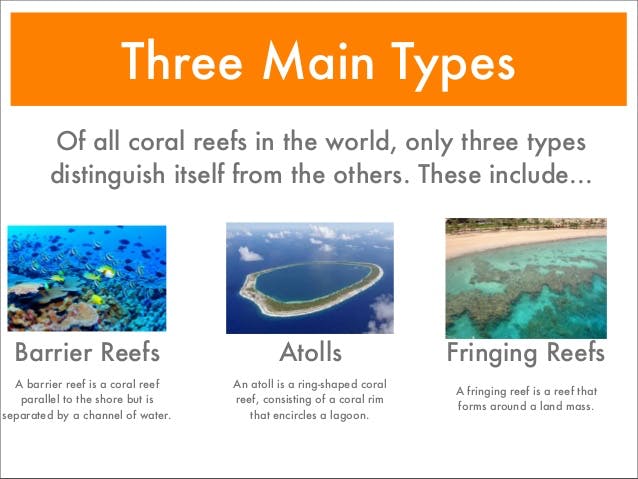
|
COLD WATER/ DEEP SEA CORAL REEFS:
- They are the corals found in the deeper, darker parts of the oceans, at depths beyond 2,000 m and temperatures of 4 °C.
- Unlike tropical corals, cold-water corals don't have symbiotic algae living in their polyps and hence don’t need sunlight to survive. They feed solely by capturing food particles from the surrounding water.
- Cold-water coral reefs are commonly found where current flow is accelerated. They are found on the continental shelf, and also in deep sea areas with topographic highs, such as seamounts, mounds, ridges, and pinnacles.
- They grow slowly, but the polyps are much bigger than tropical corals and form they extensive reefs.
- The largest reef yet discovered, off the coast of Norway's Røst Island, is 40km long and 2-3 km wide
|
CONDITIONS FOR THE GROWTH OF CORAL POLYPS:
- Extensive submarine platforms for the formation of colonies by the coral polyps (not more than 90m below sea level.)
- High mean annual temperature ranging 20-21°C. Hence, they are mainly seen in tropical seas and oceans.
- Sufficient amount of sunlight and oxygen. Thus, they do not live in deeper waters i.e. not more than 60-77m below sea level.
- Clean sediment-free water because muddy water or turbid water clogs the mouths of coral polyps resulting into their death.
- Oceanic salinity ranging between 27-30 ppt. High oceanic salinity or fresh water is injurious for the growth of corals. Hence, they avoid river mouths and waters containing little amount of calcium carbonates.
- Ocean currents and waves, as they bring food supply for the polyps.
DISTRIBUTION OF CORALS:
- World:
- The majority of reef building corals are found within tropical and subtropical waters, ie between 30 degree north and 30 degree south latitudes.
- More than 100 countries have a coral reef within their borders, and over half of the world’s coral reefs are found within six countries: Australia, Indonesia, Philippines, Papua New Guinea, Fiji, and the Maldives.
- Corals are also found farther from the equator in places where warm currents flow out of the tropics, such as in Florida and southern Japan.
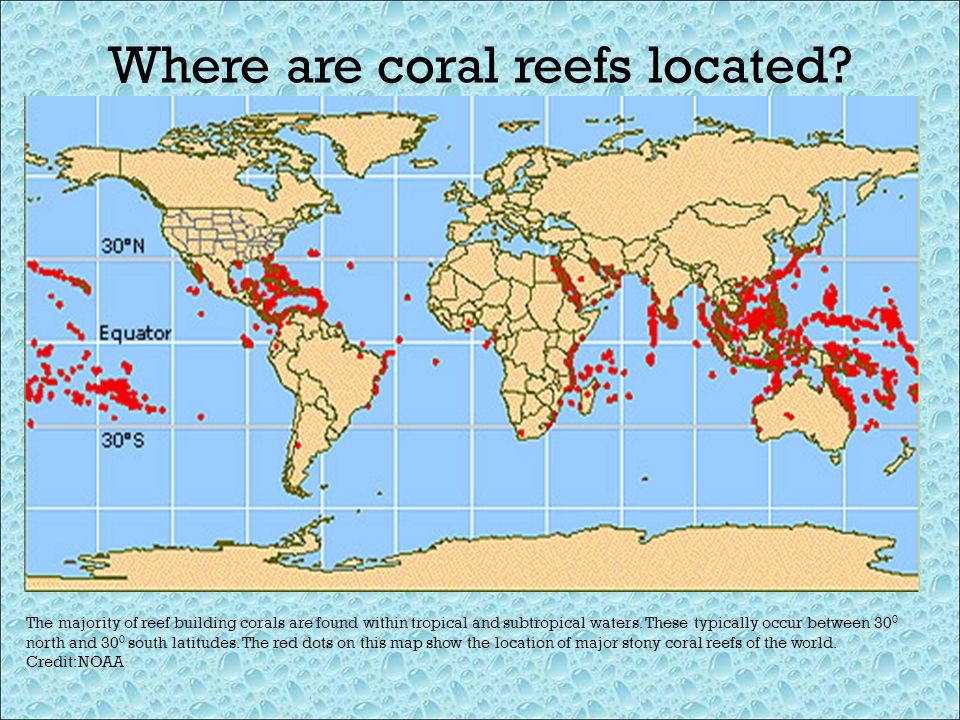
- India:
- Gulf of Kutch, Gulf of Mannar, Andaman and Nicobar, Lakshadweep Islands, Netrani Island in Karnataka, Angria Bank in Maharashtra etc.

SIGNIFICANCE:
- Ecological:
- Biodiversity: Often called "rainforests of the sea", shallow coral reefs form some of Earth's most diverse ecosystems. They occupy less than 0.1% of the world's ocean area, yet they provide a home for at least 25% of all marine species.
- Carbon sequestration: Coral reefs remove Carbon Dioxide from the atmosphere and are thus responsible for mitigation of gobal warming.
- Environmental Indicator: Coral reefs are environmental indicators of water quality because they can only tolerate narrow ranges of temperature, salinity, water clarity, and other water conditions.
- Air Quality: Corals use the dissolved carbon dioxide in the ocean water to form new reefs. This gas conversion to limestone shell controls the carbon dioxide levels in the ocean. Without coral’s activity, carbon dioxide could saturate the ocean and air mass above it.
- Economic:
- Fishing: Coral reefs and their associated habitat, such as mangroves and seagrass beds, provide an important fishing ground.
- Tourism: - Diving tours, fishing trips, hotels, restaurants, and other businesses based near reef systems provide millions of jobs and contribute billions of dollars all over the world.
- Coral resources: Mining for calcium-based components, aquarium trade, jewellery, pearls etc. contributes to the growth of blue economy.
- Medicines: Coral reefs are potential source of important medicines including drugs with anticancer, antimicrobial and antiviral activity. The calcium carbonate source provided by corals is used for bone marrow transplantation.
- Disaster Management:
- Coastal protection: Reefs serve as natural barriers against storm surges and tsunamis, preventing the destruction of coastline and protecting communities.
- Coastlines protected by reefs are more stable, in terms of erosion, and are also a source of sand in natural beach replenishment.
- Coral reefs can reduce as much as 97% of total wave energy, greatly limiting the impacts to the protected land and calming the waters on the backside of the reef, thus allowing for the trapping and accretion of sand.
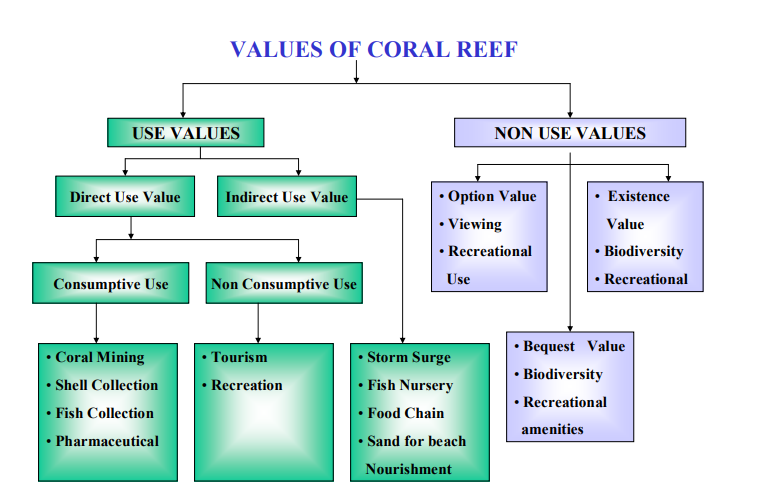
THREATS TO CORAL REEFS:
- Local threats:
- Physical damage
- It includes destruction from coastal development, dredging, quarrying, destructive fishing practices and gear, boat anchors and groundings, and recreational misuse (touching or removing corals).
- Pollution that originates on land but finds its way into coastal waters. This includes:
- Sedimentation from coastal development, urban stormwater runoff, forestry, and agriculture.
- Excessive nutrients (nitrogen and phosphorous) from agricultural and residential fertilizer use, sewage discharges and animal waste, which can lead to the growth of algae that blocks sunlight and consumes oxygen corals need for respiration.
- Toxic pollutants from industrial discharges, sunscreens, urban and agricultural runoff, mining activities, and runoff from landfills.
- Trash and micro-plastics from improper disposal and stormwater runoff.
- Overfishing
- It can alter the food-web structure and cause cascading effects, such as reducing the numbers of grazing fish that keep corals clean of algal overgrowth.
- Blast fishing (i.e., using explosives to kill fish) can cause physical damage to corals as well.
- Coral harvesting
- Coral harvesting for the aquarium trade, jewelry can lead to over-harvesting of specific species, destruction of reef habitat, and reduced biodiversity.
- Global Threats:
- Increased ocean temperatures due to global warming.
- Change in ocean chemistry, caused by increasing levels of Carbon Dioxide in seawater leading to Ocean Acidification.
- Increases in ocean acidity reduce the availability of dissolved salts and ions needed by corals to form the calcium carbonate structure, thereby slowing the growth of coral reefs. If acidification becomes severe, coral skeletons will dissolve.
- Changes in climate, which affects the flow of ocean currents and thereby impacts the nutrient availability for corals.
CORAL BLEACHING:
- When corals are stressed by changes in conditions such as temperature, light, or nutrients, they expel the symbiotic algae living in their tissues, causing them to turn completely white. This phenomenon is called Coral Bleaching.
- When a coral bleaches, it is not dead. Corals can survive a bleaching event, but as they come under more stress, they are subject to mortality.

- Roughly one-quarter of coral reefs worldwide are already considered damaged beyond repair, with another two-thirds under serious threat.
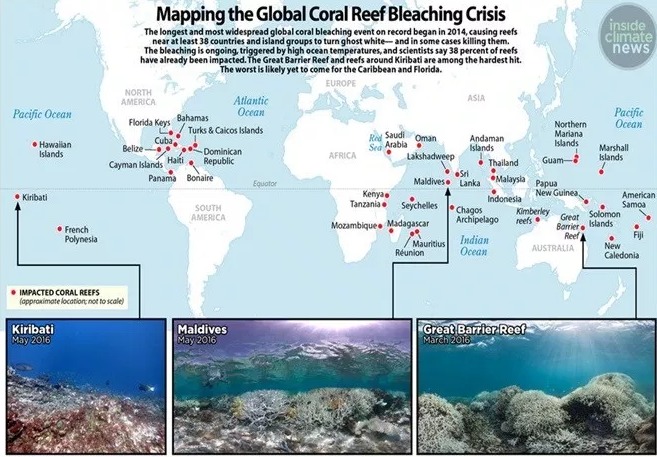
CAUSES OF CORAL BLEACHING:
- Change in ocean temperature: Increased Ocean temperature caused by climate change is the leading cause of coral bleaching.
- Runoff and pollution: Storm generated precipitation can rapidly dilute ocean water and runoff can carry pollutants these can bleach near-shore corals.
- Overexposure to sunlight: When temperatures are high, high solar irradiance contributes to bleaching in shallow-water corals.
- Extreme low tides: Exposure to the air during extreme low tides can cause bleaching in shallow corals.
- Xenobiotics: A xenobiotic is a chemical substance found within an organism that is not naturally produced or expected to be present within the organism. Zooxanthellae loss occurs during exposure of coral to elevated concentrations of various chemical contaminants, such as Cu, herbicide and oil.
INITIATIVES TO PROTECT CORAL REEFS:
INTERNATIONAL LEVEL:
- UN Sustainable Development Goals – Goal #14 (Life below water)
- Global Coral Reef Partnership - Initiated by UNEP and Regional Seas Conventions and Action Plans to support countries deliver internationally agreed coral reef commitments through ecosystem-based management of coral reefs.
- International Coral Reef Initiative (ICRI) - a partnership of Nations and organizations which strives to preserve coral reefs and related ecosystems.
- Global Coral Reef Monitoring Network - works through a global network to strengthen the provision of best available scientific information on and communication of the status and trends of coral reef ecosystems, for their conservation and management.
- Global Coral Reef Alliance- a coalition of volunteer scientists, divers, environmentalists and other individuals and organizations, committed to coral reef preservation.
|
CLIVE WILKINSON REPORT:
- The first report on the “Status of Coral Reefs of the World” was published in 1998 by the Global Coral Reef Monitoring Network, edited by Clive Wilkinson. Since then, the report was published regularly with updates on reef status in different regions and countries of the world.
- The report predicted that almost all the reefs would soon be coming in the threatened stage. The initial report focused more on pollution, over-fishing and other human stresses to corals. However, the increasing frequency, scale and the severity of the events led scholars to conclude that coral reefs are one of the first ecosystems where the impacts of unexpected global warming and ocean acidification are clearly visible to everyone around.
|
NATIONAL LEVEL:
- Legislative:
- Coral reef is included in Schedule I of the Wild Life Protection Act, 1972 which affords it the highest degree of protection.
- Protected Areas, viz. National Parks, Sanctuaries and Marine Biosphere Reserve have been created all over the country under the provisions of the Wild Life (Protection) Act, 1972 to conserve marine life including coral reef.
- Environment Protection Act 1986.
- Water (Prevention and Control of Pollution) Act 1974.
- Regulatory:
- The Coastal Regulation Zone (CRZ) Notification (2019) and the Island Protection Zone (IPZ) Notification (2019) regulates the development activities along the Sea coast and tidal influenced water bodies. To enforce them, the Ministry of Environment and Forests has constituted the National and State/UT level Coastal Zone Management Authorities.
- Zoological Survey of India has been undertaking studies on the serious threat to coral colonies in India. The mangroves and coral reefs areas are categorized as ecological sensitive areas (CRZ-I) where no new constructions are permitted with a few exceptions
- Research:
- Zoological Survey of India has been undertaking studies on the serious threat to coral colonies in India.
SUGGESTIONS:
- Check marine pollution:
- Strong and coordinated action to address land-based pollution as 80% marine pollution originates from land addressing three priority source categories, namely marine litter, nutrient management, and wastewater
- Sustainable use of marine resources:
- Encouraging sustainable use of the coral ecosystem by controlling overfishing, reef mining etc. and banning harmful practices like bottom trawling, cyanide fishing, blast fishing etc.
- Ecosystem approach:
- Ecosystem approach to conserving the coastal ecosystem involving coral reefs, mangroves and sea grass beds.
- Recognizing and classifying protected areas:
- Promoting effective marine protected areas and regulating shipping, tourist activities, coastal construction etc.
- Awareness generation:
- Creating awareness among local people about the importance of coral reefs and involving them in the conservation of coral ecosystems.
- Use of technology:
- Promoting the growth of corals through artificial means like Biorock/ Mineral Accretion Technology etc.
- Research and development:
- Investing in research and development and documentation of genetic characteristics of reef communities to enable the management of reef ecosystems through modern techniques and international collaboration.
PRACTICE QUESTION:
Q. Discuss the significance of and threats faced by coral reefs?






